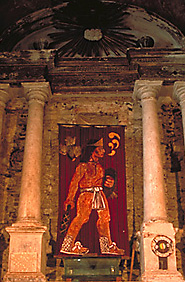|
TRADITIONS OF MEXICO El Dia de los Muertos |
|||
|
An educational project of the Houston Institute for Culture |
|||
|
SUGAR SKULLS AND FLOWERS FOR THE DEAD Celebration of the Dead Preserves Traditions of the past By Mark D. Lacy
El Dia de los Muertos is celebrated in Mexico by decorating shop windows, cleaning and decorating the cemetery, creating special fantastic flower wreaths, making small and large toys and figurines featuring the famous calaveras (skulls and skeletons sometimes accompanied by verses), and by installing tianguis (special temporary markets) to sell the necessary items for the ofrendas. Zenpasuchitl, a type of marigold, is the traditional flower of the occasion and altars are often covered with the bright orange petals. The baker, confectioner, cook, florist and artist are essential to the Days of the Dead. The most important manifestations of this holiday are the ofrendas, or altars made of offerings, created in homes, businesses and public places. The altars honor the dead to assure the continuity of life. In the Mexican tradition, those who are dead provide the necessary connection between the living and God and the Saints. The preparation for this important celebration begins the last week of October when all is readied for a great feast after the October 31st visit to friends and relatives in the cemetery. Special dishes are cooked for the ofrendas, and are usually offered to both living and dead friends and relatives who visit. The celebration is often called Los Dias de los Muertos because two important days are recognized. November 1, All Saints' Day, is devoted to los angelitos (little children), and November 2, All Souls' Day, to adults. See photos of El Dia de los Muertos Altars. Also, see the PBS documentary, Food for the Ancestors. | |||
| TRADITIONS OF MEXICO PROJECT OVERVIEW HOUSTON INSTITUTE FOR CULTURE |
